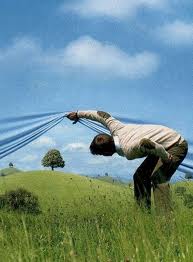Secrets of Visual Storytelling: 7 Fab How-To Articles

There is a lot of interest these days in visual storytelling because images are processed faster by the brain, and they are way more memorable than text. So mastering the ins-and-outs of visual storytelling is key if you want to grow your business, gain more visibility, or make a difference in the world.
So I have gone through my stash of best articles on visual storytelling (103 of them!) and chosen the best seven to share with you. I start out with an orientation of visual thinking (an essential skill for creating visual stories), then move on to the mechanics of creating visual memories (what visual stories do), chat about an amazing article pointing to the future of visual storytelling (you won’t want to miss this one!), and then give you two articles on visual story mechanics — image categories and story structures.
The last two articles give different examples of how companies are using visual storytelling in different ways. All the articles contain examples.
There’s lots of fun here and fabulous material to explore. So let’s get to it. Click on the headings below to get to the article.
Visual Thinking Landscape + cool videos!
As this article says, “Visual thinking is a way to organize your thoughts and improve your ability to think and communicate. It’s a way to expand your range and capacity by going beyond the linear world of the written word, list and spreadsheet, and entering the non-linear world of complex spatial relationships, networks, maps and diagram. It’s also about using tools — like pen and paper, index cards and software tools — to externalize your internal thinking processes, making them more clear, explicit and actionable.”
Before being able to be a great visual storyteller, it’s important to understand visual thinking and to build skills in this area. Not only does this article by Dave Gray share about why visual thinking is so important today in business, it has a number of videos to share to help you get started.
Bottom line, visual thinking helps you be a better storyteller. So go read the short article and watch the fun videos! These will help you tell stories better, and help you in in all kinds of presentations inside your company or with clients. They are perfect for weekend/Sunday consumption and will get your creative juices flowing 🙂
Creating A Lasting Impression | Smashing Magazine
 This article by C. Knight and J. Glaser at Smashing Magazine is long but a fascinating read — especially for anyone who wants to know more about the how and why of creating visual memories. That is the ultimate goal of visual storytelling – creating visual memories in people so they will remember your memorable product or service.
This article by C. Knight and J. Glaser at Smashing Magazine is long but a fascinating read — especially for anyone who wants to know more about the how and why of creating visual memories. That is the ultimate goal of visual storytelling – creating visual memories in people so they will remember your memorable product or service.
Storytelling is creating art in the air. That means it is ephemeral and only lives on in the person who heard the story. So the story we tell has to be compelling in order for it to stick in the minds of our listeners, and be repeated. This article on facilitating visual memory is provocative on several levels.
- First, it talks about what visual memory is and what goes into making them.
- Second, it discusses in depth several examples of how companies have created powerful visual memories.
- Third, even though this article talks about graphic design, many of the same principles apply to storytelling.
- Fourth, if you want to know about how to bring the ephemeral art of storytelling into the built environment or websites or promotional materials as story triggers, this article is rich in examples and insights.
Once you have a compelling story to share, then start thinking about how you can create visual memories to have your stories stick even longer and more powerfully in the minds of your listeners.
Why it’s time to rethink visual storytelling on the web from the bottom up
Now here is a very provocative piece! It’s web producer and publisher Adam Westbrook proposing a new idea for visual storytelling on the web. Or suggesting we start looking for one. Either way, Westbrook is definitely on the cutting edge. This piece is way out there and helping to push the boundaries of visual storytelling.
Even better, this is all presented in story form. With a very different kind of visual presentation than you are used to. So Westbrook is walking his talk here.
Both Westbook’s ideas and his presentation are very creative and glimpse into the future. I know you will enjoy both, and get a taste for where visual storytelling on the Internet is going.
UX: 7 Product Image Categories for Biz Stories
 And if you are selling one or more products, creating a story of that product that is paired with visual images is critical. So how do you start choosing those images to pair with your story?
And if you are selling one or more products, creating a story of that product that is paired with visual images is critical. So how do you start choosing those images to pair with your story?
This article by Christian Holst at Baymard Institute has good answers! There are 7 image categories to choose from. The ones that are most directly related to visual storytelling are Lifestyle images, Customer images, Textural images, Inspiration images, and Animate images.
The post contains terrific examples & explanations of each category so you will get lots of ideas. I hope this helps in your visual storytelling!
Visual Storytelling: The Key Weapon to Content Marketing
Want examples of companies doing great visual storytelling that also shows the story structures you could use to create your visual stories? Then this article by Jason Cormier is for you.
These videos are terrific examples of how businesses have applied 7 basic plots to create effective visual stories that define their brand. These are based on Christopher Booker’s book, The Seven Basic Plots: Why We Tell Stories, which covers the most successful story types through the ages.
4 Businesses Leveraging Storytelling With Images
 As this article from says, “The good news is that visual storytelling isn’t a high-cost strategy. Consumers aren’t looking for the highest-quality visual content. Consumers want stories told in a visual way that encourage, engage, enlighten and entertain.”
As this article from says, “The good news is that visual storytelling isn’t a high-cost strategy. Consumers aren’t looking for the highest-quality visual content. Consumers want stories told in a visual way that encourage, engage, enlighten and entertain.”
The post by Ekaterina Walter at Social Media Examiner gives example of the different ways companies are using visual storytelling. Like GE visually sharing its story of the future, Target sharing user generated visual stories, how PopCosmo uses Pinterest to generate and share more visual stories from customers, and how Gala Darling has taken personal branding in her business to new heights with visual storytelling.
I also like the advice at the end of the article about how to leverage visual stories. There are great tips here and the comments to the article even more illuminating. Enjoy digging in here and getting ideas you can apply to your organization.
12 Lessons From Warby Parker’s Annual Report
Corporate annual reports are fabulous opportunities for companies to tell their story. But they are often boring, no matter how gorgeous their layouts are.
Why so boring? Because they are usually filled with formal corporate speak about the year’s milestones and paragraphs about the numbers.
That information is important, yet as Warby Parker shows us, there are fresh ways to make these points that is more narrative based. And makes a much more impact. There are 12 ‘lessons’ or tips here in this post by Ross Crooks on Forbes for how to take corporate information and make it more visual. And how to take formal corporate speak and shift it to talking more about your people.
Use these tips for any kind of business communication other than annual reports:
- Websites
- Marketing material
- Sales material
All of the ideas presented here are great ways to ‘storify’ business communication.
In my next article I’ll list some of the cool tools I’ve come across to create your amazing visual stories. And these don’t include platforms like Pinterest, Instagram, Vine, or Facebook! So stay tuned . . .
Karen Dietz
Latest posts by Karen Dietz (see all)
- 5 Story Secrets For Content Creators: Standing Out From The Crowd - July 30, 2014
- Get Funny! Using Humor To Boost Shares + ROI - July 8, 2014
- 7 Best Posts on Creating Content for Emotional Engagement - June 11, 2014


